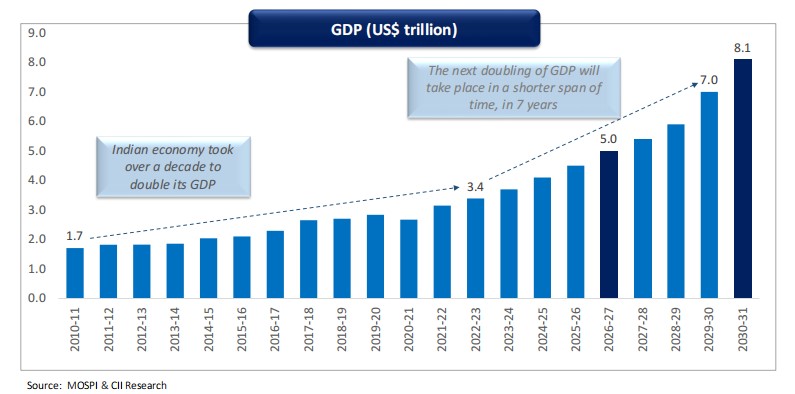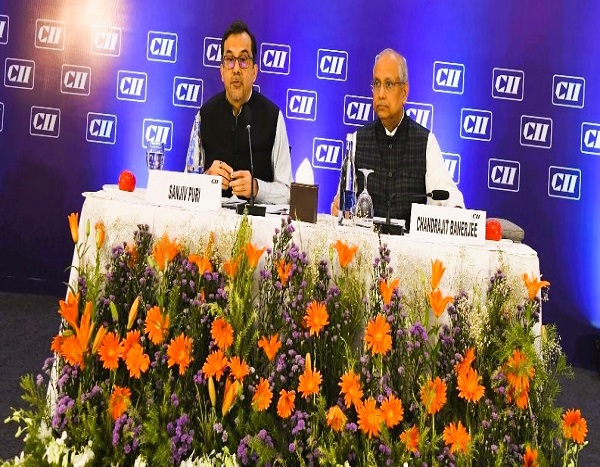The Confederation of Indian Industry (CII), a non-profit, non-government industry-led, and industry-managed organisation, held a press conference at The Lalit, New Delhi. The event was addressed by Sanjiv Puri, President, CII, and Chandrajit Banerjee, Director General, CII.
The agenda of the conference was to provide an overview of the macroeconomic outlook of the country and present a 14-point agenda for the new government
Projecting a strong outlook for the Indian economy this year, Sanjiv Puri said, “The growth rate is expected to reach 8% this year, marking the fourth consecutive year of growth above 7%. However, this estimate depends on addressing the remaining reform agenda, improving global trade to boost our exports, strong performance from investment and consumption, and the expectation of a normal monsoon, among other factors.”

He added, “The impressive growth expected this fiscal year is driven by six key factors that have accelerated the economy. These include private sector investment, public investment in physical and digital infrastructure, a well-capitalised banking system, a booming capital market, and reduced dependence on oil. Together, these factors are propelling India’s growth story.”
Puri outlined a 14-point agenda for the new government to drive the next phase of economic transformation. These were:
- Agriculture
- Create an Inter-State Agri Reform Council to build consensus on agri reforms between the Centre and states.
- Launch programs for producer collectives to boost farmers’ income.
- Develop warehousing infrastructure.
- Set up a national grid for market intelligence and crop planning.
- Promote technology adoption in agriculture and pursue stable agri-export policies.
2. Regulatory Reforms and Ease of Doing Business
- Enhance competitiveness by strengthening the ease of doing business.
- Intervene in areas such as land, power, and logistics.
- Simplify, rationalise, and decriminalise regulatory compliances.
- Implement time-bound clearances via the National Single Window System.
- Strengthen the alternate dispute resolution system.
- Adopt self-declaration, third-party certification, and deemed approvals where feasible.
3. Expenditures on Technology and R&D
- Reduce power costs through cross-subsidisation.
- Operationalise the Rs 1 lakh crore fund to encourage innovation and R&D in the private sector.
- Build a strong ecosystem by connecting academic and research institutions with industry.
- Evolve regulatory framework with AI.
4. Environmental Sustainability
- Promote green growth to tackle climate change and support de-carbonisation.
- Establish a National Commission on Adaptation, a National Mission on Water Security, and a Green Transition Fund for mitigation and adaptation.
5. Global Engagement
- Deepen integration with Global Value Chains.
- Set up a Global Trade Promotion Body with dedicated overseas offices for branding and promotion.
6. Rural Development
- Develop rural industrial parks and connectivity infrastructure for the market.
- Launch a smart village program by leveraging digital technology to transform the rural landscape.
- Facilitate industry engagement with the National Rural Livelihood Mission for mentorship and entrepreneurship training.
7. Skill Development
- Focus on skill development initiatives.
- Launch Employment Linked Incentive (ELI) schemes with outcome indicators for labour-intensive sectors.
- Address low female participation by offering higher incentives for hiring female labour.
- Investments
- Continue the capex-led growth strategy, increasing capital expenditure by 25% in FY25.
- Prioritise developing India’s human capital.
9. GST Reforms
- Create institutional platforms similar to the GST Council.
- Implement a three-rate GST structure.
10. Financial Growth
- Privatise two public sector banks.
- Diversify funding sources for NBFCs to expand their reach.
- Rationalise and simplify capital gains tax and TDS provisions.
11. Employment Opportunities
- Establish an International Mobility Authority under MEA to track employment opportunities abroad.
- Set up an industry task force to promote women’s employment opportunities and opportunities in general in the fields of STEM, Green Energy, EVs, Electronics, and many more emerging sectors.
12. Startups
- Create physical and digital infrastructure with a startup incubator, accelerator, investors, and academic & research scholars under one roof to support end-to-end facilitation.
- Accessibility to youth in Tier 2 and Tier cities and villages.
13. Health & Education
- Raise public health expenditure to 3% of GDP and education expenditure to 6% by 2030.
- Set up task forces for tracking NEP implementation statewide.
- Hospitals to be considered as infrastructure investments
- Leverage digital technology to boost both sectors.
14. Tourism
- Launch a National Tourism Policy to boost sector growth.
- Include Tourism in the Seventh Schedule of the Constitution of India under the Concurrent list.
- Introduce Incredible India 3.0 with appointed brand ambassadors to revive international tourism.
- Mission Suraksha: Provide around-the-clock security at major tourist destinations and build dedicated Tourist Police.
In addition to the missions, CII has planned several new initiatives for this year. These include setting up the CII Alternative Dispute Resolution Centre. Recently, Prime Minister Narendra Modi launched the CII-TVS Mobility Centre of Excellence on Employment and Livelihood. Additionally, the CII-Rahul Bajaj Centre of Excellence on Skills will establish high-tech AI-driven sectoral skill labs in high-growth sectors like manufacturing, healthcare, hospitality, financial services, IT/ITES & UI/UX, automotive (including EVs), green energy, and drone technology.
Such initiatives will help the Indian economy to stand out and strengthen its position as the fastest-growing economy in the world.




